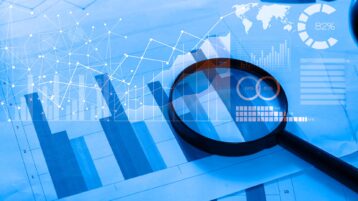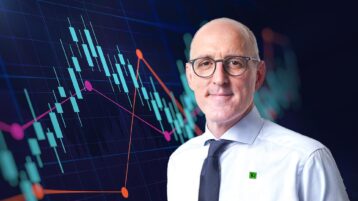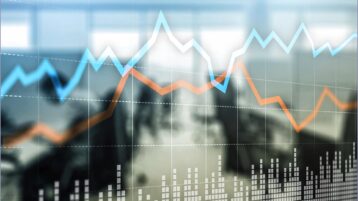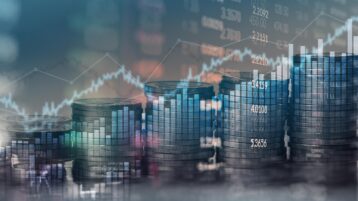The U.S. Federal Reserve left its key lending rate on hold after 10 straight meetings, but signaled that additional rate hikes are likely this year. Anthony Okolie speaks with Andrew Hencic, Senior Economist at TD, about the Fed’s decision to skip a rate increase and what it means for financial markets.
Print Transcript
[AUDIO LOGO]
As expected, the Fed paused on raising its key rates, but they also signaled more rate hikes to come. Joining me to discuss this latest decision and its impact on financial markets is Andrew Hencic, Senior Economist with TD.
Andrew, did anything catch your attention today?
Well, as you mentioned, as expected, the Fed paused. There was no hike today. But it was really the hawkish tone of the messaging that came along with the pause that was a tad surprising. The median from the dot plot indicates possibly two more hikes this year. You know, from our view, it was a bit of a hawkish pause where the messaging was definitely signaling for the potential for more rate hikes to come.
And signaling of more rate hikes to come, how much further do you think the Fed will go before they stop raising interest rates?
Well, our view is now that we're going to get one more this year, so another 25 basis point hike. Really in this phase of the cycle, where they're looking at the incoming data as it comes along and having to make their decisions one step at a time, and so from our view there's likely to be one more hike before the end.
And as you mentioned, the Fed is signaling at least two more hikes. How have the bond markets reacted to the news and what are the yield curves telling us about the US economy and about the potential for recession next year?
Well, look, yields jumped when the statement came out. I mean, look, the yield curve is inverted. The longer term yields are below the near term ones. Markets are expecting the economy to slow down and for the Fed's policy rate to eventually have to have to come off these very high levels. So from that regard, we see the economy slowing into the back half of this year and into next year. Markets expect the economy to slow down and for the Fed to eventually have to start lowering its policy rate.
And looking ahead, what are the indicators that you'll be watching closely as the Fed considers its next move?
Look, all eyes are going to be on the labor market here. Payrolls growth has been very healthy. Labor demands still looks to be very strong. The Fed is going to be looking for some signs that things are cooling off there, that wage and wage pressures are coming off and ultimately going to lead to some easing inflationary pressures. So all eyes on the labor market. It's going to tell us what's likely to be coming down.
Let's talk about the US dollar. Where do you see the US dollar going over the next little while?
Look, I mean, with expectations for rates kind of moving up after this meeting, the downside to the USD in the near term is a little bit smaller. It's true, other central banks are still hiking and may have a little bit further to go than the Fed. But this hawkish tone really kind of limits the downside to the USD. Looking forward, though, as the global economy rolls over, that will also add a little bit of strength to the dollar, as those flows to safety and demand for safe assets kind of increase.
Andrew, thanks very much for your time.
Thank you very much for having me, Anthony.
[AUDIO LOGO]
[MUSIC PLAYING]
As expected, the Fed paused on raising its key rates, but they also signaled more rate hikes to come. Joining me to discuss this latest decision and its impact on financial markets is Andrew Hencic, Senior Economist with TD.
Andrew, did anything catch your attention today?
Well, as you mentioned, as expected, the Fed paused. There was no hike today. But it was really the hawkish tone of the messaging that came along with the pause that was a tad surprising. The median from the dot plot indicates possibly two more hikes this year. You know, from our view, it was a bit of a hawkish pause where the messaging was definitely signaling for the potential for more rate hikes to come.
And signaling of more rate hikes to come, how much further do you think the Fed will go before they stop raising interest rates?
Well, our view is now that we're going to get one more this year, so another 25 basis point hike. Really in this phase of the cycle, where they're looking at the incoming data as it comes along and having to make their decisions one step at a time, and so from our view there's likely to be one more hike before the end.
And as you mentioned, the Fed is signaling at least two more hikes. How have the bond markets reacted to the news and what are the yield curves telling us about the US economy and about the potential for recession next year?
Well, look, yields jumped when the statement came out. I mean, look, the yield curve is inverted. The longer term yields are below the near term ones. Markets are expecting the economy to slow down and for the Fed's policy rate to eventually have to have to come off these very high levels. So from that regard, we see the economy slowing into the back half of this year and into next year. Markets expect the economy to slow down and for the Fed to eventually have to start lowering its policy rate.
And looking ahead, what are the indicators that you'll be watching closely as the Fed considers its next move?
Look, all eyes are going to be on the labor market here. Payrolls growth has been very healthy. Labor demands still looks to be very strong. The Fed is going to be looking for some signs that things are cooling off there, that wage and wage pressures are coming off and ultimately going to lead to some easing inflationary pressures. So all eyes on the labor market. It's going to tell us what's likely to be coming down.
Let's talk about the US dollar. Where do you see the US dollar going over the next little while?
Look, I mean, with expectations for rates kind of moving up after this meeting, the downside to the USD in the near term is a little bit smaller. It's true, other central banks are still hiking and may have a little bit further to go than the Fed. But this hawkish tone really kind of limits the downside to the USD. Looking forward, though, as the global economy rolls over, that will also add a little bit of strength to the dollar, as those flows to safety and demand for safe assets kind of increase.
Andrew, thanks very much for your time.
Thank you very much for having me, Anthony.
[AUDIO LOGO]
[MUSIC PLAYING]



























